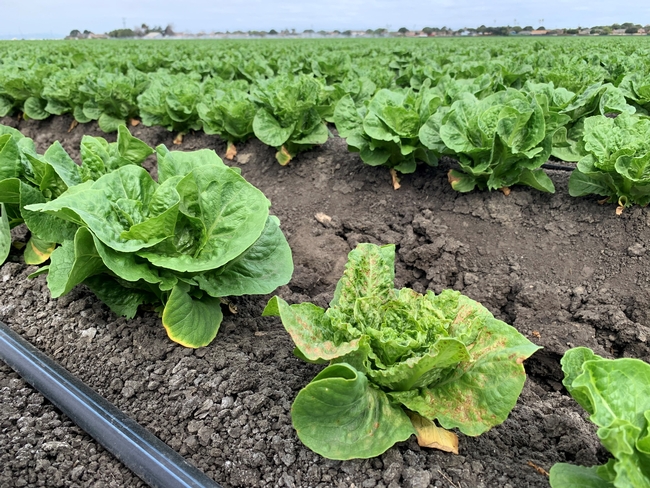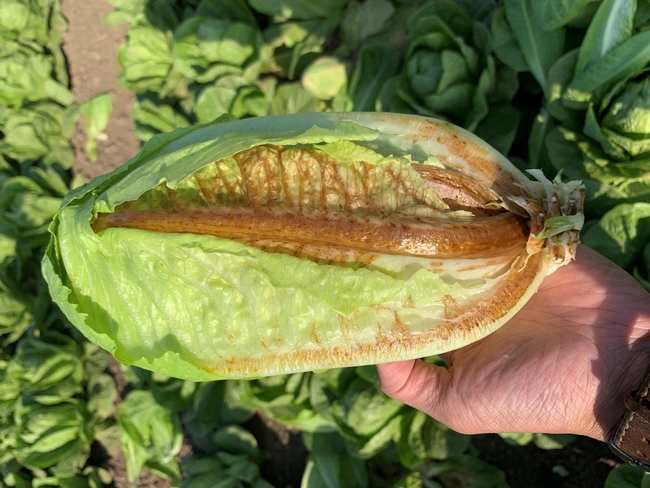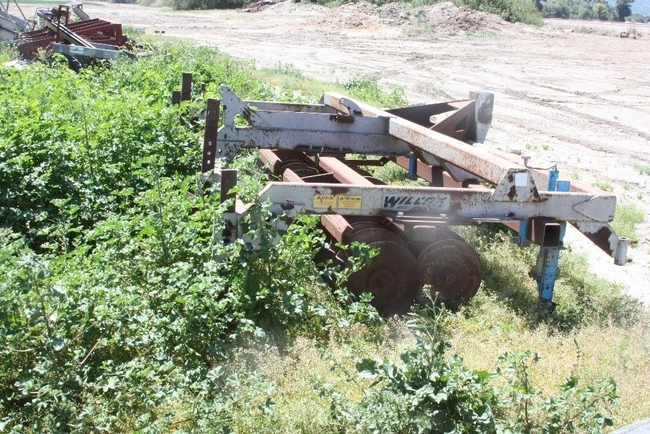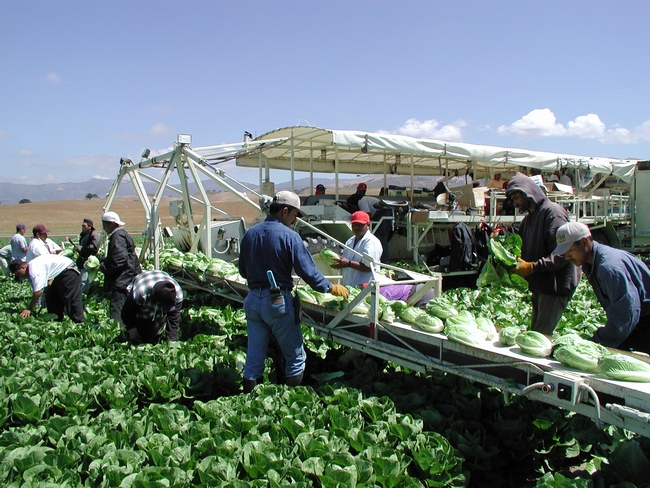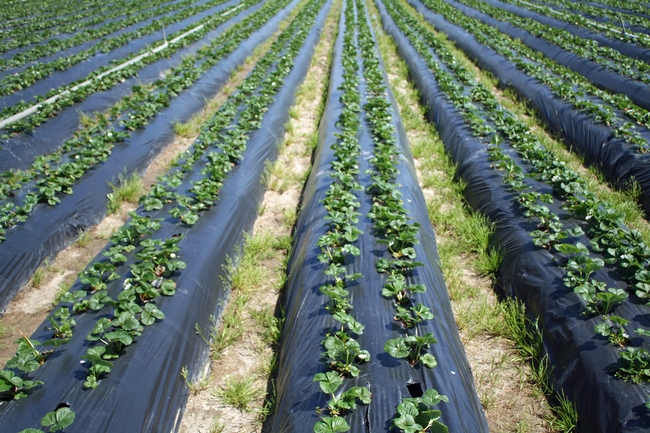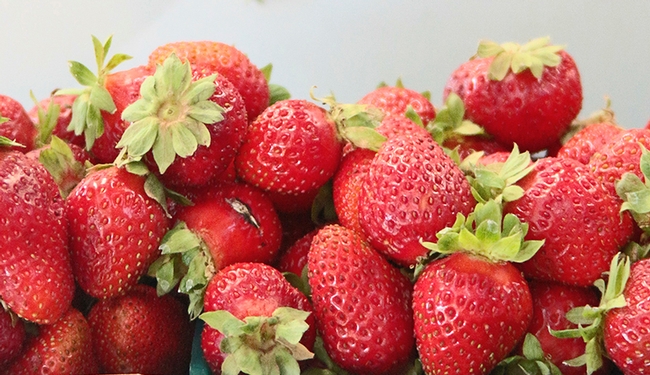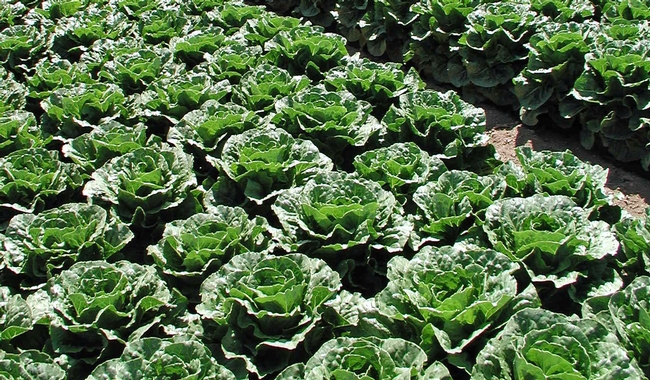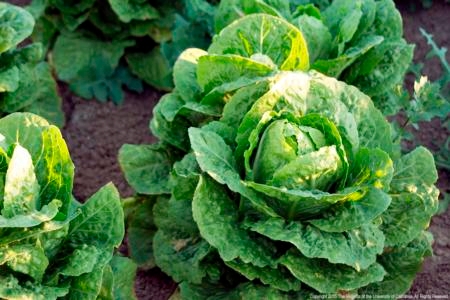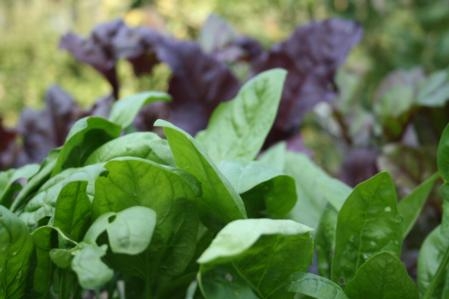Posts Tagged: romaine
Lettuce growers hope weeding, research can counter devastating plant virus
Population explosion of insect vector contributed to $100 million in losses in 2020
While most Californians are wholeheartedly embracing the wet start to winter, one group is welcoming the rain more warily (and wearily) – lettuce growers in the Salinas Valley.
“It's a blessing, yes, we need the water,” said Tony Alameda, managing partner of Topflavor Farms, which grows a variety of produce in Monterey and San Benito counties. “But, oh gosh: with that water, here come the weeds, here comes the habitat, here comes all the other problems that go along with it.”
Weeds are overwintering havens for a tiny insect called the Western flower thrips, which in turn carries the impatiens necrotic spot virus (INSV) – a plant virus that caused $100 million in lost gross revenue for Salinas Valley growers in 2020.
The agricultural community called it “the biggest problem we've seen in a long, long time,” said Mary Zischke, facilitator of a task force convened by the Grower-Shipper Association to address INSV and a related affliction, Pythium wilt.
Widespread crop failure in 2020
Since INSV was first observed in the state in 2006, the virus – which poses no threat to people – triggered significant crop losses in 2019, leading up to a catastrophic 2020. As Alameda's lettuces began to show the telltale “bronzing” of the leaves, efforts to bag up or remove the infected plants had no effect on the virus' implacable spread.
“Nothing seemed to work,” he recalled, “and you just watch those fields collapse, week after week, until you're just like, ‘Ugh, there's nothing here to even harvest.'”
After “100% crop failure” that year in his prime fields at the heart of the Salinas Valley, Alameda tried to dodge the virus in 2021 – shifting lettuce plantings to San Benito County and instead using his most valuable land for unaffected crops such as cilantro, leeks and radishes. By decamping to San Benito, Alameda was able to harvest 70% of his usual lettuce yield.
Generally, growers enjoyed a reprieve from virus pressures in 2021. Even in this “good” year, however, about one-third of all lettuce plantings in the Salinas Valley had at least a low level of infection, according to Zischke.
“Since we were attributing a lot of our so-called good fortune – on having less damage this year – to the cooler weather, we know we can't count on that to get us out of this problem,” Zischke said. “All the models point to the fact that we're in a warming climate, so we were fortunate this year.”
More research needed on thrips
Heat waves were a major driver of the INSV disaster of 2020. Although researchers have established a link between warmer temperatures and population increases of thrips, science still has a lot to learn about those disease vectors.
“Thrips are something we're trying to understand as much as we can, but it's pretty tough because they're a little mysterious in the way they get around and where they overwinter,” said Richard Smith, a University of California Cooperative Extension vegetable crops and weed science farm advisor for the Central Coast region.
Smith – along with U.S. Department of Agriculture research entomologist Daniel Hasegawa and California State University-Monterey Bay plant pathologist JP Dundore-Arias – provided an INSV update during an Assembly agriculture committee hearing in December.
Recent studies have identified several weeds as key “reservoirs” of thrips, including malva, marestail, and hairy fleabane. The ubiquitous mustards, fortunately, appear to be poor hosts for thrips, although their pollen serve as potential food sources.
Controlling those weeds – which are beginning to spring up as the days lengthen – is a top priority during the winter months, according to Smith. Aggressive weed management in the preceding winter was an important factor in limiting the virus' spread in 2021.
And because weeds recognize no boundaries, experts are also urging managers of non-agricultural lands to keep their properties as clean as possible, including industrial sites, equipment yards and the edges of roadways – namely U.S. Route 101, which runs through the center of the valley. Some growers have been volunteering to weed their neighbors' vineyards.
“We're encouraging everybody – as best they can – to knock down known weed hosts; that's really critical,” Zischke said.
Search for long-term solutions
Within the grower community, there is “nervous optimism” for the coming year, said Alameda, as he continues to hope for an innovation that would aid in the fight against INSV – whether a more targeted pesticide application or a beneficial insect that could deter the thrips.
However, both Alameda and Zischke pointed to the breeding of more resistant lettuce varieties as the ultimate solution to INSV – albeit one that is years away.
“We have a lot of different types of lettuce that we grow, so to move resistance into all the different types of lettuce we grow throughout the season … that's going to take time,” Zischke explained.
Research funding from the state and USDA – as well as projects supported by the California Leafy Greens Research Program – can help expedite that process. But, for Alameda, the INSV crisis underscores the need for more resources and farm advisors such as Smith, who has spent more than three decades cultivating relationships and building trust within Salinas Valley communities.
Alameda would like to see a renewed focus on bringing “bright, young, passionate people who live and breathe this stuff” to the region, so growers are better equipped to handle the inevitable next calamity.
“Hopefully this is a wakeup call to all,” he said. “This is a valued industry – you have to take care of it; it cannot be taken for granted. The ‘salad bowl of the world' cannot rest on its laurels.”
Thinking about growing romaine or organic strawberries? UC ANR releases sample costs
Farmers who are considering growing romaine hearts or organic strawberries in California's Central Coast region can get some help determining whether the crop will pencil out for them.
UC ANR Agricultural Issues Center and UC Cooperative Extension have released sample costs to produce and harvest organic strawberries for fresh market and romaine lettuce hearts in Santa Cruz and Monterey counties.
A major difference between growing strawberries organically and the conventional practice is in weed control.
“Weed management is especially challenging for organic strawberry production because soil fumigation and most herbicides are not allowed under organic regulations,” said Mark Bolda, UC Cooperative Extension farm advisor in Santa Cruz County. “Weeds in furrows between the beds can be mechanically cultivated during the growing season, but most of the weeding will need to be done by hand from December through September.”
The cost analyses are based on hypothetical well-managed farming operations using practices common to the Central Coast region. The costs, materials and practices shown in the studies will not apply to all farms and are intended to assist growers in estimating their own costs.
The organic strawberry study assumes a farm with conventionally grown strawberry transplants planted on 27 contiguous acres of rented land. “Organic strawberry transplants are part of the picture now, but not standard by a long shot,” said Bolda, who co-authored the cost studies. The strawberry crop is harvested by hand and packed into trays containing eight 1-pound clamshells, from April through early October with peak harvest in June and July.
For romaine lettuce for the hearts market, the cost study assumes a farm of 1,500 non-contiguous acres of rented land, with romaine planted on 250 acres and rotated with other lettuce and cool season vegetable crops to assist with pest management and soil fertility. Lettuce is planted continuously from late December to mid-August along the Central Coast. To manage lettuce mosaic virus, Monterey County has a host-free period (December 7 – 21), during which time lettuce may not be planted. In this study, lettuce is planted in January.
For both the organic strawberries and romaine, ranging analysis tables show net profits over a range of prices and yields. Other tables show the monthly cash costs, the costs and returns per acre, hourly equipment costs, and the whole farm annual equipment, investment and business overhead costs. The authors describe the assumptions they used to identify current costs for production material inputs and overhead.
The authors have also expanded the section on labor, which includes information on California's minimum wage and overtime laws.
Growers, UC ANR Cooperative Extension farm advisors and other agricultural associates provided input and reviewed the methods and findings of both studies.
Free copies of these and other sample cost of production studies for many commodities are available. To download the cost studies, visit the UC Davis Department of Agricultural and Resource Economics website at https://coststudies.ucdavis.edu.
For more information about calculations used in the romaine hearts and organic strawberriesstudies, contact the Agricultural Issues Center at (530) 752-4651 or Mark Bolda at UC Cooperative Extension in Santa Cruz County at (831) 763-8025.
The cost and returns studies program is funded by the UC Agricultural Issues Center and UC Cooperative Extension, which are part of the UC Division of Agriculture and Natural Resources, and the UC Davis Department of Agricultural and Resource Economics.
Cost estimates for growing romaine hearts and organic spinach released
Two new studies on the costs and returns of growing romaine hearts and organic spinach have been released by UC Agriculture and Natural Resources' Agricultural Issues Center.
Sample costs to produce and harvest romaine hearts and organic spinach in the Central Coast Region – Monterey, Santa Cruz and San Benito counties – are presented in these studies.
The analysis is based upon a hypothetical farm operation of a well-managed farm, using practices common to the region. Input and reviews were provided by growers, UC ANR Cooperative Extension farm advisors and other agricultural associates. Assumptions used to identify current costs for these crops, material inputs, cash and non-cash overhead are described. A ranging analysis table shows profits over a range of prices and yields. Other tables show the monthly cash costs, the costs and returns per acre, hourly equipment costs, and the whole farm annual equipment, investment and business overhead costs.
The new studies are titled “2015 Sample Costs to Produce and Harvest Romaine Hearts in the Central Coast Region” and “2015 Sample Costs to Produce and Harvest Organic Spinach in the Central Coast Region.”
These two studies can be downloaded for free from the UC Davis Department of Agriculture and Resource Economics website at http://coststudies.ucdavis.edu. Cost-of-production studies for many commodities are also available.
For additional information or an explanation of the calculations used in the studies, contact Don Stewart at the UC ANR Agricultural Issues Center at (530) 752-4651 or destewart@ucdavis.edu.

